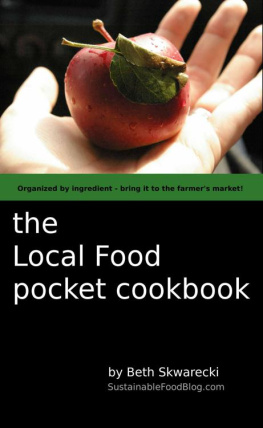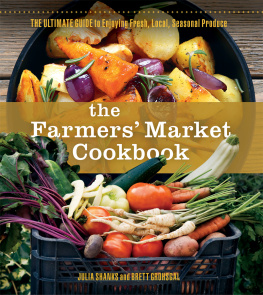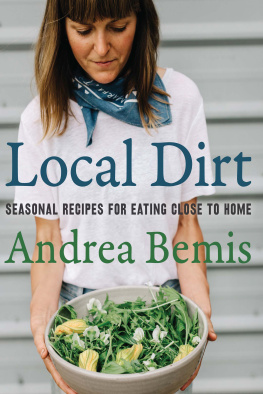Table of Contents How this book can help you 7 What's so great about local food? 9 Basics 11 ACORN SQUASH 17 APPLES 17 ASPARAGUS 20 BEANS 22 BEEF 23 BEETS 25 BERRIES 26 BROCCOLI 28 BUTTERNUT SQUASH 30 CABBAGE 30 CARROTS 32 CHEESE 35 CHICKEN 35 COLLARD GREENS 38 COOKING GREENS 38 CORN 40 CRANBERRIES 42 CUCUMBERS 44 GARLIC 44 GREEN BEANS 45 HERBS 46 EGGS 48 EGGPLANT 48 KALE 49 LAMB 49 MILK AND CREAM 51 ONIONS 52 PEARS 53 PEPPERS 54 PORK 54 POTATOES 56 PUMPKINS 57 SPINACH 57 SUMMER SQUASH 58 SWISS CHARD 59 TOMATOES 59 TOMATILLOS 63 TURKEY 64 TURNIPS 65 WINTER SQUASH 66 ZUCCHINI 71
How this book can help you
This book is organized by ingredient.
So when you see some blue potatoes at the market, you can flip to potatoes and pick out a recipe right away. Find the other ingredients at neighboring market stalls, and you're ready to cook!
Your foodshed is unique, and every area has its own vocabulary of ingredients that informs the local cuisine. This book provides ideas, but it's up to you to fill in the blanks.
So when a recipe calls for oil or butter, I might use butter and you might use soybean oil. Or if I call for a tomato, you might have Brandywines in your garden and I might pick up a Cherokee Purple at the market.
The recipes are all seasonal - for example, a winter soup will never depend on summer vegetables.
The recipes are all seasonal - for example, a winter soup will never depend on summer vegetables.
The recipes are also vegetarian wherever possible.
What's so great about local food?
When you buy food from a local farmer, you're supporting your local economy. That's great for starters.
If you buy fresh, local produce, you're getting food that you could never get in a grocery shipment from some faraway place like tomatoes that are vine-ripened (they taste the best, but wouldn't survive a truck ride) or antique apple varieties that have commercially unappealing brown skins but the most perfectly sweet-tart flesh you've ever tasted.
You can get sweet corn picked that morning, blue potatoes and purple green beans, soft fat heirloom tomatoes, tender varieties of turnips, the very earliest asparagus in spring all while chatting with the farmers (or wandering in your own garden). You're reducing your carbon footprint while supporting healthy, humane agriculture and local businesses.
That's what's so great about local food.
(I write about local, sustainable food every day at www.SustainableFoodBlog.com .)
Basics
If you prefer your breads, pastas, and other staples to be local, you might need to make them yourself. Search out locally milled flour at a food co-op, and try some of these recipes.
Easy homemade bread Time: 1.5 hours (about 15 minutes active work)
- 2.5 cups flour (any kind)
- 2.5 tsp dry yeast (1 packet)
- 1 cup warm water 105 degrees
- 1 tsp salt
- 1 tsp sugar (optional)
In a large bowl (use a mixer with a dough hook, if you have one) mix the flour and salt.
In a small bowl, combine the yeast, sugar, and warm water. (You may also omit the sugar and skip this step, adding the yeast and water directly to the bowl of flour.)
Knead or mix the dough until it's smooth, and let it rest for 20-30 minutes in the bowl.
Form the dough into one or two loaves.
Form the dough into one or two loaves.
For sandwich bread, roll a log that fits into a loaf pan. For baguette style loaves, roll up long thin logs. For boules, make round lumps.
Slash the top of your loaves with a knife (be decorative, if you like) and let them rest for 30-60 minutes, in a warm place. The top of a preheating oven is a good spot.
Preheat the oven to 375, and bake the now large, puffy loaves for about 20 minutes, or until they're golden on top and make a thump sound when tapped.
Let the loaves cool before slicing them open.
Was that fun? There's a whole art and science of bread baking. For starters, try www.breadnet.net or The Bread Baker's Apprentice .
Another easy recipe is Jim Lahey's no-knead bread, published in the NY Times (just google it).
Homemade egg pasta
Pasta is easy to make yourself, whether you want a fresh fettuccine or you're dying to make some custom ravioli (see the winter squash section for a great ravioli filling).
- 1 egg
- 1 cup flour
- water and flour available for sprinkling
Clean off a wooden table or other work surface.
Dump your flour and cracked egg right on the table. How much pasta do you want? Double or triple the recipe if you like.
Mix the egg and flour together into a dough; add a splash of water if the dough is too dry. Sprinkle flour all over your surface, and roll out the dough. If the dough is too rubbery to behave, let it rest for 5-10 minutes before continuing.
If you've got a pasta machine, go ahead and use it.
Otherwise, just keep rolling until the dough is very thin. For fettuccine, fold the well-floured dough and cut it into strips.
For ravioli, divide the sheet of dough in half. On one half, spoon the filling in a grid pattern, say a half-teaspoon every 1.5 inches.
Sprinkle water over the dough (wet dough will stick to itself) and cover with the other half. Press the top and bottom layers of dough together, making sure not to trap any air bubbles in the pockets with the filling.
Cut the ravioli apart from each other, using a ravioli cutter if you have one.
Boil the pasta to cook. Fresh fettuccine cooks in about 2 minutes, ravioli in 3-4. Serve with your favorite pasta sauce, such as the simple aglio e olio you can find under garlic .
Pie crust This is my mom's crust.
- 2 sticks butter, slightly softened
- 2 cups flour
- 1 egg
Cut the butter into the flour using a pastry blender, then mix in the egg.
- 2 sticks butter, slightly softened
- 2 cups flour
- 1 egg
Cut the butter into the flour using a pastry blender, then mix in the egg.
If the dough is very crumbly, add a splash of water.
Divide the dough in half (it makes two crusts, for the top and bottom) and roll out each portion on a well-floured surface. If the dough cracks, just patch it back together with a dab of flour and water.
For a fruit pie, cut the dough into strips and layer them lattice-style on top of the pie. This is often easier than rolling out a sheet for the top crust layer.
APPLES
Apple/Peach Pie Make this with apples, peaches, or a combination of your favorite fruits.
- 5 cups of washed, sliced fruit (about 3 pounds of apples or peaches)
- 1/2 cup flour, or as needed
- 1 cup sugar, or to taste
- 1/2 tsp cinnamon
- two pie crusts (see recipe in basics )
Preparation: Take the butter out of the fridge to soften (if you're making your own crust) while you wash and slice your fruit.
- 5 cups of washed, sliced fruit (about 3 pounds of apples or peaches)
- 1/2 cup flour, or as needed
- 1 cup sugar, or to taste
- 1/2 tsp cinnamon
- two pie crusts (see recipe in basics )
Preparation: Take the butter out of the fridge to soften (if you're making your own crust) while you wash and slice your fruit.









